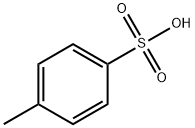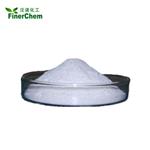Overview
p-toluene sulfonic acid (Its molecular structural formula is p-CH3C6H4SO3H, also known as TsOH, English name is p-toluene sulfonic acid) referred to as PTS, is a non-oxidizing organic acid, white needle or powder crystals, soluble in water, alcohols, ethers and other polar solvents. Easy deliquescence, easy to make wood, cotton fabric dehydration and carbonization, insoluble in benzene and toluene. generating p-cresol when alkali fusion. Commonly, p-toluenesulfonic acid-monohydrate (TsOHH2O) or tetrahydrate (TsOH4H2O) is preferred.
Preparation of methyl p-cresol acid in industry is by using concentrated sulfuric acid on the toluene sulfonation of p-toluenesulfonic acid. The preparated p-toluenesulfonic acid often contains benzene sulfonic acid and sulfuric acid impurities, can be purified in recrystallization of concentrated hydrochloric acid, azeotropic drying.
p-toluene sulfonic acid is widely used as catalyst agent in the synthesis of pharmaceuticals, pesticides, polymerization stabilizer and organic synthesis (esters, etc.), paint intermediates and resin curing agent. And it is also the commonly used acid catalyst in organic synthesis. It is neutralized with sodium hydroxide and then obtains sodium p-toluene sulfonate, and react with phosphorus pentachloride, can obtains p-toluenesulfonyl chloride. The latter used in the nucleophilic substitution reaction, also used as alcohol hydroxyl protective group. p-CH3C6H4SO3Na + PCl5 →p-CH3C6H4SO2Cl.
The use of p-toluenesulfonic acid also catalyzes the protection of dihydrofuran on the alcohol, carboxylic acid esterification, transesterification reaction, making the aldehyde generate acetal.
Refer to quality standards
Item/Index Industrial Grade Pharmaceutical Grade Refined Grade Reagent Grade (Chemically Pure)
Content (as C7H8O3S • H2O)% ≥ 90-93.0 96.0 97.0 98.0
Free acid (H2SO4) ≤% 3.0 0.7 0.5 0.1
Moisture (excluding crystal water) ≤% 4.0 3.5 2.5 1.5
Iron (in Fe ++) ≤ ppm 50 30 30 10
Ignition residue ≤%/0.2 0.2 0.02
Melting point (°C)// 102-105
Ethanol dissolved test/qualified qualified qualified
Water dissolution test/qualified qualified qualified
Chemical properties
Colorless monoclinic sheet or columnar crystals. Soluble in ethanol and ether, slightly soluble in water and hot benzene.
Uses
(1) For chemical reagents, but also for dyes, organic synthesis.
(2) Used as the intermediates of medicine (such as doxycycline), pesticides (such as dicofol), dyes. Also used in detergents, plastics, coatings and so on.
(3) For medicine, pesticides, dyes and detergents, but also for plastics and printing coatings.
(4) Widely used in the catalyst synthetic medicine, pesticides, polymerization of the stabilizer and organic synthesis (esters, etc.). Also used as medicine, paint intermediates and resin curing agent.
Production method
By p-toluenesulfonyl chloride hydrolysis derived. Toluene can also be used as raw materials, sulfonated by sulfuric acid derived.
Hazards & Safety Information
Category:Corrosive articles
Toxicity classification:Low toxicity
Acute toxicity
Oral-rat LD50: 2480 mg/kg
Flammability hazard characteristics
Combustible; fire in the release of toxic sulfur dioxide gas
Storage and transportation characteristics
Storehouse is ventilates, low temperature and dry; Store with base separately
Extinguishing agent
Mist water, carbon dioxide, foam
Description
p-Toluene sulfonic acid (PTSA) or tosylic acid (TsOH) is an organic compound with the formula CH
3C
6H
4SO
3H. It is a white solid that is soluble in water, alcohols, and other polar organic solvents. The 4-CH
3C
6H
4SO
2- group is known as tosyl group and is often abbreviated as Ts or Tos. Most often, TsOH refers to the monohydrate, TsOH.H
2O.
TsOH is a strong organic acid, about a million times stronger than benzoic acid. It is one of the few strong acids that is solid and, hence, conveniently weighed. Also, unlike some strong mineral acids (especially nitric acid, sulfuric acid, and per chloric acid), TsOH is non - oxidizing.
Chemical Properties
Clear colorless to light yellow solution
Uses
p-Toluenesulfonic Acid Hydrate (Lisinopril EP Impurity B) is used in the synthesis of resveratrol. Also used in the synthesis of oxane derivatives as antimalarial agents.
Definition
ChEBI: p-Toluenesulfonic acid is an arenesulfonic acid that is benzenesulfonic acid in which the hydrogen at position 4 is replaced by a methyl group. It is a member of toluenes and an arenesulfonic acid. It is a conjugate acid of a toluene-4-sulfonate.
Reactions
p-Toluene sulfonic acid may be converted to p-toluene sulfonic anhydride by heating with phosphorus pentoxide.
When TsOH is heated with acid and water, a hydrolysis reaction takes place and toluene is formed:
CH
3C
6H
4SO
3H + H
2O → C
6H
5CH
3 + H
2SO
4 This reaction is general for aryl sulfonic acids, but the rate at which it occurs depends upon the structure of the acid, the temperature and the nature of the catalyzing acid. For example p- TsOH is unaffected by cold concentrated hydrochloric acid, but hydrolyzes when heated to 186°C in concentrated phosphoric acid.
Flammability and Explosibility
Non flammable
Tosylate esters
Tosylate esters are used as alkylating agents because the tosyl group is electron-with drawing, which makes the tosylate anion a good leaving group. The tosyl group is also a protecting group for alcohols and amines, prepared by combining the alcohol with 4- toluenesulfonyl chloride, usually in an aprotic solvent, often pyridine, the basicity of which activates the reaction. Toluenesulfonate esters undergo nucleophilic attack or elimination. Reduction of tosylate esters gives the hydrocarbon. Thus, tosylation followed by reduction allows for the deoxygenation of alcohols.
Preparation and handling
TsOH is prepared on an industrial scale by the sulfonation of toluene. It hydrates readily. Common impurities include benzene sulfonic acid and sulfuric acid. Impurities can be removed by recrystallization from its concentrated aqueous solution followed by azeotropic drying with toluene.
Toluene sulfonic acid finds use in organic synthesis as an "organic - soluble" acid catalyst. Examples of uses :
Acetalization of an aldehyde.
Esterification of carboxylic acids.
Trans esterification of an ester.
Toxics Screening Level
The initial threshold screening levels (ITSLs) for p-toluenesulfonic acid are 1.8 μg/m3, annual averaging time and 210 μg/m3, 1 hour averaging time.




